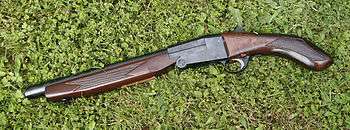Lupara
- For the "comune" in Italy, see Lupara, Molise.

Lupara is an Italian word used to refer to a sawn-off shotgun of the break-open type. It is traditionally associated with Cosa Nostra, the Italian organized crime group dominant in Sicily for their use of it in vendettas, defense—such as its use against Mussolini's army when he decided to break up the Sicilian mafioso network—and hunting.[1]
The shortened barrel (or barrels) of a lupara lend themselves to easier handling in wooded areas, or to easier concealment and indoor employment in urban areas. The lack of choke contributes to a wider spread of shot when the weapon is fired.
Terminology
The word lupara means literally "for the wolf", reflecting its traditional use in wolf hunting. The word achieved wider recognition through Mario Puzo's bestselling novel The Godfather where the lupara is used extensively by the mafia in Sicily, including Michael Corleone's bodyguards.[2]
From the word lupara comes the Italian expression lupara bianca (blank lupara), a term especially used by journalists to refer to a mafia-style slaying in which the victim's body is deliberately hidden.[3]
Famous usage
An early example of criminal use of the weapon in the United States was the assassination of the New Orleans chief of police, David Hennessy, in October 1890.[4] The murder punctuated a rivalry between gangs of Sicilian fruit company stevedores whose contracts did not fall under the auspices of the local longshoreman's union. A pile of sawn-off shotguns was displayed after the murder, including a homemade gun with a folding iron stock, and another with a hook on its stock to brace against the arm when firing one armed. Anti-Italian provocation, following the failed prosecution of a group of suspected men, resulted in a mob assault on the New Orleans Parish Prison and the subsequent lynching of many Italian prisoners.[5][6]
References
- ↑ Chalker, Dennis; Dockery (2002). One Perfect Op : an Insider’s Account of the Navy Seal Special Warfare Teams. New York: Morrow. p. 251. ISBN 0-671-02465-5.
- ↑ Puzo, Mario (2002). The Godfather. New York: NAL. pp. 192, 203, 329, 335, 337, 349. ISBN 978-0-451-20576-6.
- ↑ Vocabolario Treccani online (ed.). "Lupara".
- ↑ Smith, Tom (2007). The Crescent City Murders. The Lyons Press. ISBN 1-59228-901-0.
- ↑ Chief Hennessy avenged, The New York Times, March 15, 1891
- ↑ Anti-Italian Mood Led to 1891 Lynchings, Times Picayune Newspaper, March 14, 1991
External links
 The dictionary definition of lupara at Wiktionary
The dictionary definition of lupara at Wiktionary